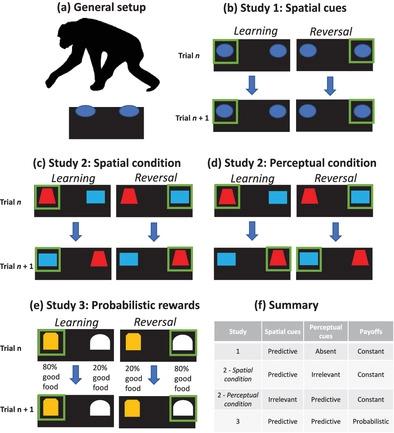Our official English website, www.x-mol.net, welcomes your
feedback! (Note: you will need to create a separate account there.)
The origins of cognitive flexibility in chimpanzees
Developmental Science ( IF 3.1 ) Pub Date : 2022-04-09 , DOI: 10.1111/desc.13266 Averill Cantwell 1 , Joshua W Buckholtz 2, 3 , Rebeca Atencia 4 , Alexandra G Rosati 1, 5
Developmental Science ( IF 3.1 ) Pub Date : 2022-04-09 , DOI: 10.1111/desc.13266 Averill Cantwell 1 , Joshua W Buckholtz 2, 3 , Rebeca Atencia 4 , Alexandra G Rosati 1, 5
Affiliation

|
Cognitive flexibility is a core component of executive function, a suite of cognitive capacities that enables individuals to update their behavior in dynamic environments. Human executive functions are proposed to be enhanced compared to other species, but this inference is based primarily on neuroanatomical studies. To address this, we examined the nature and origins of cognitive flexibility in chimpanzees, our closest living relatives. Across three studies, we examined different components of cognitive flexibility using reversal learning tasks where individuals first learned one contingency and then had to shift responses when contingencies flipped. In Study 1, we tested n = 82 chimpanzees ranging from juvenility to adulthood on a spatial reversal task, to characterize the development of basic shifting skills. In Study 2, we tested how n = 24 chimpanzees use spatial versus arbitrary perceptual information to shift, a proposed difference between human and nonhuman cognition. In Study 3, we tested n = 40 chimpanzees on a probabilistic reversal task. We found an extended developmental trajectory for basic shifting and shifting in response to probabilistic feedback—chimpanzees did not reach mature performance until late in ontogeny. Additionally, females were faster to shift than males were. We also found that chimpanzees were much more successful when using spatial versus perceptual cues, and highly perseverative when faced with probabilistic versus consistent outcomes. These results identify both core features of chimpanzee cognitive flexibility that are shared with humans, as well as constraints on chimpanzee cognitive flexibility that may represent evolutionary changes in human cognitive development.
中文翻译:

黑猩猩认知灵活性的起源
认知灵活性是执行功能的核心组成部分,是一套认知能力,使个人能够在动态环境中更新自己的行为。与其他物种相比,人类的执行功能被认为得到增强,但这一推论主要基于神经解剖学研究。为了解决这个问题,我们研究了黑猩猩(我们现存的近亲)认知灵活性的本质和起源。在三项研究中,我们使用逆转学习任务检查了认知灵活性的不同组成部分,在这些任务中,个体首先学习一种意外情况,然后在意外情况发生翻转时必须改变反应。在研究 1 中,我们测试了n = 82 只从幼年到成年的黑猩猩执行空间反转任务,以表征基本转移技能的发展。在研究 2 中,我们测试了n = 24 只黑猩猩如何使用空间与任意感知信息进行转变,这是人类和非人类认知之间的差异。在研究 3 中,我们测试了n = 40 只黑猩猩执行概率逆转任务。我们发现了基本转变和响应概率反馈的转变的扩展发展轨迹——黑猩猩直到个体发育晚期才达到成熟的表现。此外,女性的转变速度比男性更快。我们还发现,黑猩猩在使用空间线索与感知线索时更加成功,并且在面对概率结果与一致结果时高度坚持。这些结果确定了黑猩猩与人类共有的认知灵活性的核心特征,以及对黑猩猩认知灵活性的限制,这可能代表了人类认知发展的进化变化。
更新日期:2022-04-09
中文翻译:

黑猩猩认知灵活性的起源
认知灵活性是执行功能的核心组成部分,是一套认知能力,使个人能够在动态环境中更新自己的行为。与其他物种相比,人类的执行功能被认为得到增强,但这一推论主要基于神经解剖学研究。为了解决这个问题,我们研究了黑猩猩(我们现存的近亲)认知灵活性的本质和起源。在三项研究中,我们使用逆转学习任务检查了认知灵活性的不同组成部分,在这些任务中,个体首先学习一种意外情况,然后在意外情况发生翻转时必须改变反应。在研究 1 中,我们测试了n = 82 只从幼年到成年的黑猩猩执行空间反转任务,以表征基本转移技能的发展。在研究 2 中,我们测试了n = 24 只黑猩猩如何使用空间与任意感知信息进行转变,这是人类和非人类认知之间的差异。在研究 3 中,我们测试了n = 40 只黑猩猩执行概率逆转任务。我们发现了基本转变和响应概率反馈的转变的扩展发展轨迹——黑猩猩直到个体发育晚期才达到成熟的表现。此外,女性的转变速度比男性更快。我们还发现,黑猩猩在使用空间线索与感知线索时更加成功,并且在面对概率结果与一致结果时高度坚持。这些结果确定了黑猩猩与人类共有的认知灵活性的核心特征,以及对黑猩猩认知灵活性的限制,这可能代表了人类认知发展的进化变化。











































 京公网安备 11010802027423号
京公网安备 11010802027423号